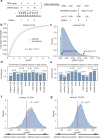Genome-wide impact of codon usage bias on translation optimization in Drosophila melanogaster
- PMID: 39333102
- PMCID: PMC11437122
- DOI: 10.1038/s41467-024-52660-4
Genome-wide impact of codon usage bias on translation optimization in Drosophila melanogaster
Abstract
Accuracy and efficiency are fundamental to mRNA translation. Codon usage bias is widespread across species. Despite the long-standing association between optimized codon usage and improved translation, our understanding of its evolutionary basis and functional effects remains limited. Drosophila is widely used to study codon usage bias, but genome-scale experimental data are scarce. Using high-resolution mass spectrometry data from Drosophila melanogaster, we show that optimal codons have lower translation errors than nonoptimal codons after accounting for these biases. Genomic-scale analysis of ribosome profiling data shows that optimal codons are translated more rapidly than nonoptimal codons. Although we find no long-term selection favoring synonymous mutations in D. melanogaster after diverging from D. simulans, we identify signatures of positive selection driving codon optimization in the D. melanogaster population. These findings expand our understanding of the functional consequences of codon optimization and serve as a foundation for future investigations.
© 2024. The Author(s).
Conflict of interest statement
The authors declare that they have no competing interests.
Figures





Similar articles
-
Synonymous codon usage regulates translation initiation.Cell Rep. 2023 Dec 26;42(12):113413. doi: 10.1016/j.celrep.2023.113413. Epub 2023 Dec 12. Cell Rep. 2023. PMID: 38096059 Free PMC article.
-
Codon usage regulates protein structure and function by affecting translation elongation speed in Drosophila cells.Nucleic Acids Res. 2017 Aug 21;45(14):8484-8492. doi: 10.1093/nar/gkx501. Nucleic Acids Res. 2017. PMID: 28582582 Free PMC article.
-
Pervasive Strong Selection at the Level of Codon Usage Bias in Drosophila melanogaster.Genetics. 2020 Feb;214(2):511-528. doi: 10.1534/genetics.119.302542. Epub 2019 Dec 23. Genetics. 2020. PMID: 31871131 Free PMC article.
-
Synonymous but Not Silent: The Codon Usage Code for Gene Expression and Protein Folding.Annu Rev Biochem. 2021 Jun 20;90:375-401. doi: 10.1146/annurev-biochem-071320-112701. Epub 2021 Jan 13. Annu Rev Biochem. 2021. PMID: 33441035 Free PMC article.
-
Codon optimality, bias and usage in translation and mRNA decay.Nat Rev Mol Cell Biol. 2018 Jan;19(1):20-30. doi: 10.1038/nrm.2017.91. Epub 2017 Oct 11. Nat Rev Mol Cell Biol. 2018. PMID: 29018283 Free PMC article. Review.
Cited by
-
Functional synonymous mutations and their evolutionary consequences.Nat Rev Genet. 2025 May 20. doi: 10.1038/s41576-025-00850-1. Online ahead of print. Nat Rev Genet. 2025. PMID: 40394196 Review.
-
Translational fidelity and longevity are genetically linked.Nat Commun. 2025 Aug 13;16(1):7521. doi: 10.1038/s41467-025-62944-y. Nat Commun. 2025. PMID: 40804252 Free PMC article.
-
Advancing recombinant protein expression in Komagataella phaffii: opportunities and challenges.FEMS Yeast Res. 2025 Jan 30;25:foaf010. doi: 10.1093/femsyr/foaf010. FEMS Yeast Res. 2025. PMID: 40074550 Free PMC article. Review.
-
Relaxed Purifying Selection is Associated with an Accumulation of Transposable Elements in Flies.Mol Biol Evol. 2025 Jun 4;42(6):msaf111. doi: 10.1093/molbev/msaf111. Mol Biol Evol. 2025. PMID: 40417952 Free PMC article.
-
The First Complete Mitogenome Characterization and Phylogenetic Implications of Elops machnata (Teleostei: Elopiformes: Elopidae).Biology (Basel). 2025 Jun 21;14(7):739. doi: 10.3390/biology14070739. Biology (Basel). 2025. PMID: 40723300 Free PMC article.
References
Publication types
MeSH terms
Substances
Associated data
Grants and funding
LinkOut - more resources
Full Text Sources
Molecular Biology Databases

